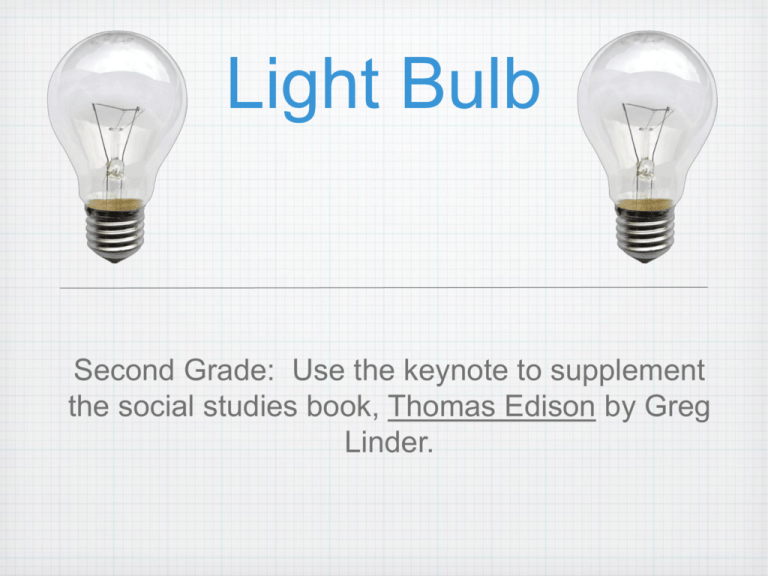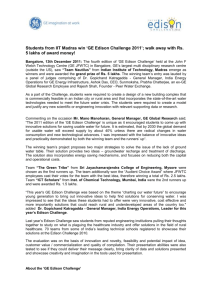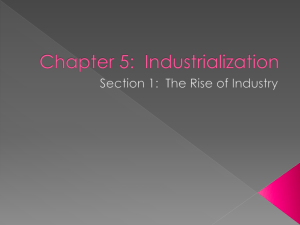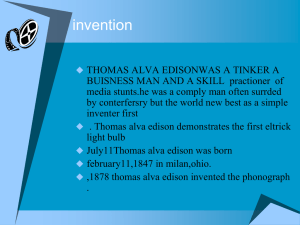Light bulb - Bloomington Public Schools
advertisement

Light Bulb Second Grade: Use the keynote to supplement the social studies book, Thomas Edison by Greg Linder. Thomas Edison’s Curiousity Whenever you turn on a light or listen to the phonograph, you are enjoying one of the inventions of Thomas Edison. Indeed, it is difficult to go through a day without using an Edison invention. Edison probably invented more things than any other person in history. Thomas Edison was always curious. As a boy he read every book he could and loved to tinker with machinery. He even set up a chemical laboratory in his cellar. But sometimes his curiosity went too far. For example, he once talked his friend Michael Oates into drinking a mixture that made gas bubbles in order to see if it would make Michael fly like a gas-filled balloon. Michael got sick, and young Edison got a whipping from his father. As Edison got older, he became more careful with his experiments, but he never stopped being curious about the world around him. More information about Thomas Edison’s life can be found on Grolier Online Kids under the key words Edison, Thomas. Melosi, Martin. "Edison, Thomas Alva." The New Book of Knowledge®. 2009. Grolier Online. 4 Mar. 2009 <http://nbk.grolier.com/cgibin/article?assetid=a2008750-h>. Thomas Edison's greatest challenge was the development of a practical incandescent, electric light. Contrary to popular belief, he didn't "invent" the lightbulb, but rather he improved upon a 50-year-old idea. In 1879, using lower current electricity, a small carbonized filament, and an improved vacuum inside the globe, he was able to produce a reliable, long-lasting source of light. The idea of electric lighting was not new, and a number of people had worked on, and even developed forms of electric lighting. But up to that time, nothing had been developed that was remotely practical for home use. Edison's eventual achievement was inventing not just an incandescent electric light, but also an electric lighting system that contained all the elements necessary to make the incandescent light practical, safe, and economical. After one and a half years of work, success was achieved when an incandescent lamp with a filament of carbonized sewing thread burned for thirteen and a half hours. http://inventors.about.com/library/inventors/bledison.htm There are a couple of other interesting things about the invention of the light bulb: While most of the attention was on the discovery of the right kind of filament that would work, Edison actually had to invent a total of seven system elements that were critical to the practical application of electric lights as an alternative to the gas lights that were prevalent in that day. These were the development of: 1.the parallel circuit, 2.a durable light bulb, 3.an improved dynamo, 4.the underground conductor network, 5.the devices for maintaining constant voltage, 6.safety fuses and insulating materials, and 7.light sockets with on-off switches. http://inventors.about.com/library/inventors/bledison.htm Thomas Edison was a hard worker, and he expected the people who helped him to also work hard. http://inventors.about.com/library/inventors/bledison.htm Sometimes he slept overnight. Before Edison could make his millions, every one of these elements had to be invented and then, through careful trial and error, developed into practical, reproducible components. The first public demonstration of the Thomas Edison's incandescent lighting system was in December 1879, when the Menlo Park laboratory complex was electrically lighted. Edison spent the next several years creating the electric industry. http://inventors.about.com/library/inventors/bledison.htm Electric Lamp On 21-22 October 1879, Edison and his staff conducted their first successful experiments with a carbon-filament lamp in a vacuum. The filament was made from a piece of carbonized thread. By New Year's he was demonstrating lamps using carbonized cardboard filaments to large crowds at the Menlo Park laboratory. A year later, Edison began manufacturing commercial lamps using carbonized Japanese bamboo as filaments . Newspaper Article: Sitting one night in his laboratory reflecting on some of the unfinished details, Edison began abstractedly rolling between his fingers a piece of compressed lampblack until it had become a slender thread. Happening to glance at it the idea occurred to him that it might give good results as a burner if made incandescent (Glowing due to heat). A few minutes later the experiment was tried, and to the inventor's gratification, satisfactory, although not surprising results were obtained. Further experiments were made, with altered forms and composition of the substance, each experiment demonstrating that the inventor was upon the right track. http://edison.rutgers.edu/lamp.htm The Electric Light Edison is best remembered for the invention of the light bulb. He was not the first to invent an electric light bulb, but he was the first to develop a complete indoor electric lighting system. Before this people did not have any way to use a bulb. There were no sockets, no switches, no insulated wires, and no central source that produced electricity. Edison's great achievement was to make electric lighting practical. By 1879 he had made a long-burning lamp, and in 1882 he built a complete lighting system on Pearl Street in New York City. In the 1880's, electric lighting and power systems were built across the United States and in many other countries. Melosi, Martin. "Edison, Thomas Alva." The New Book of Knowledge®. 2009. Grolier Online. 4 Mar. 2009 <http://nbk.grolier.com/cgibin/article?assetid=a2008750-h>. Edison Laboratory http://inventors.about.com/library/inventors/bledison.htm Light bulbs existing prior to Edison’s efforts burned for a short time ... Thomas Alva Edison, a prolific inventor, and his team (yes, he did not work alone!) experimented with thousands of different filaments to find just the right materials to glow well and be long-lasting. In 1879 Edison obtained an improved Sprengel vacuum pump, and it proved to be the catalyst for a breakthrough. Edison discovered that a carbon filament in an oxygen-free bulb glowed for 40 hours. Soon, by changing the shape of the filament to a horseshoe it burned for over 100 hours and later, by additional improvements, it lasted for 1500 hours. Edison and his colleagues had invented a practical light bulb and by doing so they opened up the way for the establishment of the electrical power system. It was this power system that became Edison's real achievement. It beget a huge new industry that would radically effect everyone. By September of 1882 he had opened a central station on Pearl Street in Manhattan and was eventually supplying electricity to a one mile square section of New York. http://www.juliantrubin.com/bigten/bulbexperiment.html Patents “A patent is a description of an invention. It is registered with the government to show who thought of it first. For a set period of time afterward, only the inventor can make, use or sell the invention. The inventor can grant permission to others to do so, for a fee, or can sell the patent outright to others. A patentt is important if an invention becomes successful,l because the person who owns the patent makes the money.” Parker, Steve. Thomas Edison and Electricity. London, England: Belitha Press Limited, 1992, pp. 6, 8 Fun Facts About Edison Joseph, Paul. Thomas Edison. Edina, MN: Abdo & Daughters, 1997, p. 20-21. Click here to have this read to you “Lewis Latimer” Britannica Elementary Encyclopedia http://www.britannica.com • History of Incandescent Bulbs • It is widely regarded that Thomas Alva Edison invented the first reasonably practical incandescent lamp, using a carbon filament in a bulb containing a vacuum. Edison's first successful test occurred in 1879. • There were earlier incandescent lamps, such as one by Heinrich Goebel made with a carbon filament in 1854. This incandescent lamp had a carbonized bamboo filament and was mentioned as lasting up to 400 hours. At least some sources regard Goebel as the inventor of the incandescent lamp. • Joseph Wilson Swan began trying to make carbon-based incandescent lamps in 1850 and made one in 1860 that was workable except for excessively short life due to poor vacuum. He made more successful inccandescent lamps after better vacuum pumps became available in the mid 1870's. • “Light Bulbs” Since that time, the incandescent lamp has been improved by using tantalum and later http://www.kidsinfobits.com tungsten filaments, which evaporate more slowly than carbon. How Has the World Changed due to the Light Bulb and Indoor Lighting?





